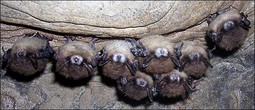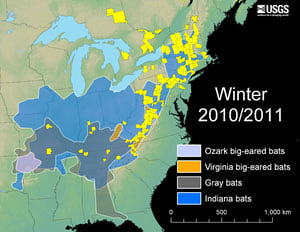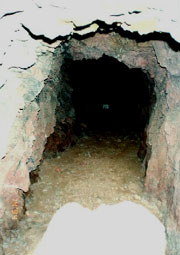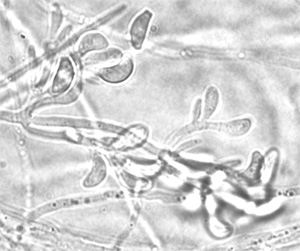White nose syndrome in bats
Introduction
White Nose Syndrome in bats is a rapidly spreading disease occurring in hibernating bats during the winter months in caves and mines. A psychrophilic fungus called Geomyces destructans, which influences the bat to conduct unusual, perilous behavior during hibernation, causes White Nose Syndrome. The fungus consumes most if not all of the winter fat storage of the bat, which makes the bat wake up from hibernation early in search of food. The bat leaves the cave but does not find any food in the dead of winter. Geomyces destructans produces reproductive spores, conidia, on the bats wings and mouth. The spores produced on the nose and wings look powdery white hence the name of the white nose syndrome. Since 2006, Geomyces destructans has spread in caves and mines in over 16 states and 4 Canadian provinces. The public has only become aware of WNS since 2006. As of January 2012, between 5.5 and 6.7 million North American bats have perished from White Nose Syndrome [1]. As bat populations decrease, certain environmental processes will be impacted such as an increase of insects, particular plants will not be pollinated, and a decrease in seed dispersal. Geomyces destructans inhibits natural bat behavior which in turn adversely affects environmental processes. In this interaction, Geomyces destructans has a negative effect on the environment and environmental processes.
Biological interaction
Pathogens
The biological interaction between Geomyces destructans and North American bats could be thought of as pathogenic (a general interaction). [2] Geomyces destructans is a type of pathogenic fungi due to the fact that it causes disease in its animal host. Geomyces destructans is transferred to the host by direct contact. Geomyces destructans quickly covers parts of the bat’s body and tissues and impacts body fat storage, ultimately resulting in the death of the infected bat. Geomyces destructans affects the bat’s typical hibernation behavior, bats store fat so that during the winter months, the bat has enough energy to survive on while hibernating. During hibernation, the bat wakes up and flies out of the cave and into the cold winter weather in search of food. To no avail, the bat finds no food and wastes some of its body fat storage. Similarly, infected bats choose to huddle near entrances of caves and mines (areas that still receive some light) during hibernation whereas normal, uninfected bats hibernate deep in caves and mines away from harsh, cold temperatures. Geomyces destructans negatively impacts North American bats by disturbing their normal winter sleeping period and causing a decreased ability to survive the winter. Geomyces destructans is a silent killer; it attacks when the bats immune system is at its lowest; while the bat is unaware of the infection. Since Geomyces destructans has affected multiple species of bats, it is categorized as horizontal transmission type of virulence.
Niche
Bats inhabit places where little human interaction occurs. Organisms living deep in caves or abandoned mines have acquired adaptations such as lack of pigmentation, increased sensory structures, reduced eyes or blindness, low reproductive rates, and elongated appendages and antennae. Organisms living in caves must be accustomed to continuous darkness, constant temperatures, and high humidity. Microbes help maintain a particular, stable environment for the bat population.
Geomyces destructans is a psychrophilic type of fungi which indicates that it is an extremophile that reproduces and grows in cold temperatures (temperatures ranging from −15°C to +10°C. Psychrophiles are able to withstand cold temperatures due to a lipid cell membrane that is chemically resistant to stiffening/freezing. Also, psychrophiles are able to create proteins that act like 'antifreezes' to keep inner membrane functions "running". With these specialized adaptations, Geomyces destructans is able to thrive in cold habitats, especially during the winter months, and remain unaffected. Further, caves maintain a stable temperature year round, so Geomyces destructans has an undisturbed habitat, which allows for growing populations.
Caves
Caves beyond the entrance have high relative humidity, total darkness, low nutrient levels, and stable temperatures. Most caves have water, fish, crayfish, crickets, other insects, bats and any organism that enjoys steady temperatures ranging from 39 – 59 degrees Fahrenheit. Caves offer a diverse array of microbial habitats. The parent rock from which caves form from is often limestone but could also be dolomite, granite, marble, sandstone, or gypsum [3]. The mineral composition that makes up the cave habitat determines what type of microbes inhabits the area. Low levels of nitrogen and organic carbon occur within the cave walls. Heterotrophs adapted to low nutrient (oligotrophic) conditions dominate in this area, as well as chemolithoautotrophs. Microbes help bats degrade guano and clean the subsurface water source. Next, bats cling to ceilings and walls of the cave so unknowingly, bats interact with microbes. As bats cling to the walls of the cave while resting, Geomyces destructans can easily move from cave walls onto the fur of the bats.
Abandoned Mines
Abandoned mines provide a diverse habitat for microbes in the mining spoils. The mining spoils have high levels of heavy metals like zinc or copper. Acid-loving microbes, like Acidithiobacillus, thrive in mine spoil piles. Old mines have an entrance/exit point where the bats can fly out. Inside the old mine, the temperature stays pretty constant like a cave unlike the fluctuating temperatures outside. Also, abandoned mines are dark and stay cool throughout the year, which is a key requirement for nocturnal creatures like bats.
Key Microorganisms
Geomyces destructans
Geomyces destructans the fungi from the class Leotiomycetes and in the phylum Ascomycota. This fungus forms conidia and conidiospores on the faces, ears, and wings of the bats. Geomyces destructans cannot function at temperatures higher than 24 degrees C (75 degrees F) but thrive in temperatures ranging from 4 – 15 degrees C (39 – 59 degrees F). Geomyces destructans has a similar temperature range as that of winter hibernacula of North American bats.
North American Bats
Bats are a key factor in a variety of ecosystem habitats. Bats help control insect populations, as that is their main food source, help pollinate particular plants, and help disperse seeds. Many of the insect species that bats consume potentially cause disease and infection of humans so, bats are a natural “pest control” (US Fish & Wildlife Service 2012). White Nose Syndrome declines crucial bat populations and will most likely have huge impacts on the ecosystems that bats inhabit.
Little Brown Bats (Myotis lucifugus)
One of the most common bats in North America. Little brown bats are found in almost all of North America. Little brown bats are insectivores. This organism is also nocturnal and it leaves its roost after dusk and before dawn. Now that Geomyces destructans is prevalent in many Northeastern caves, this species population numbers is dwindling [4].
Northern Long-Eared Bats (Myotis septentrionalis)
This species is fairly small in size but has relatively long ears. This species is dispersed along the eastern coast of the United States. Northern long-eared bats are also nocturnal and insectivorous. Right now the distribution of these bats are from Newfoundland in Canada to Florida in the United States. As Geomyces destructans progresses, the Northern Long-Eared Bats' distribution has already started to change [5].
Big Brown Bats (Eptesicus fuscus)
This species is the largest amongst these four species. The big brown bat is nocturnal and hunts insects at dusk and dawn. Big brown bats are common across the United States. This particular species is widespread but does not reach as far as florida. As Geomyces destructans might disturb Big Brown bat populations on the east coast but, since this species is also living on the west coast, this particular species might not be impacted greatly [6].
Tri-colored Bats (Perimyotis subflavus)
Tri-colored bats are commonly found throughout the eastern parts of the United States. This bat, along with the other three species, has a conservation status of “least concern.” Tri-colored bats are also nocturnal and insectivorous. This bat species is spread all over the eastern coast but has reaches as far as Nebraska and Texas. As Geomyces destructans spreads farther west, the tri-colored bat populations might be severely degraded [7].
Threat of Spreading?
Europe
In North America, 1,000 to 50,000 bats hibernate in caves or mines. Contrastingly, in Europe, bat populations hibernating in caves rarely exceeded 1,000 organisms. Potentially, Geomyces destructans could be correlated with large densities of hibernating bats. In Europe, Geomyces destructans was found but did not exude devastating characteristics like infected bats of North America. [8] It is suggested that bats in Europe are possibly immunologically or behaviorally resistant to Geomyces destructans. Geomyces destructans might have evolved around European bats for quite some time so that today, European bats can live along the fungus and remain unaffected. European bats' skin have adapted to accommodate Geomyces destructans and incorporate it as a nonpathogenic member of the microbial community. Another hypothesis states that Europe might have introduced Geomyces destructans to North America.
North America
In only a few years, Geomyces destructans has devastated bat populations along the eastern coast of the United States. Moreover, White Nose Syndrome has become an infectious disease in caves and abandoned mines of the eastern coast of the United States. As bat populations decline, farmers will see an increase in pest populations affecting their crops. Currently, the U.S. Fish and Wildlife Service is monitoring the spread of WNS across the United States and warning visitors of caves to take extra precaution in order to reduce introduction of Geomyces destructans. [9] Potentially, White Nose Syndrome could spread over the next several years to the Midwest and even the west coast of the United States. There is in depth research being conducted on the rate of spreading to the western side of the United States.
Current Research
Experimental infection of bats with Geomyces destructans causes WNS
This article suggests there is evidence lacking that Geomyces destructans is the primary source of white-nose syndrome [10]. Also, Lorch et al state that many assume that all fungal infections are commonly connected with immune system dysfunction. Finally, Geomyces destructans is commonly found on European bats’ skin but there are no large bat mortality occurrences that have led scientists to believe that Geomyces destructans is not the sole cause of white-nose syndrome.
White-nose syndrome threatens the survival of hibernating bats in North America
The USGS has compiled information concerning five species of bats: little brown bats, northern long-eared bats, Indiana bats, big brown bats, and tricolored bats[11]. White-nose syndrome had suddenly and rapidly become widespread. Geomyces destructans has played a major role in the swift decrease in bat populations on the northeastern coast.
White-nose syndrome: is this emerging disease a threat to European bats?
Geomyces destructans was found to affect North American bat populations starting in 2006. It was not until 2009 that Geomyces destructans was found to pose a threat in Europe. This article explains the planning of multiple countries trying to gain more information about white-nose syndrome and whether or not it will lead European bats to a similar outcome of North American bats [12].
References
[2] Author Unknown. 2012. "Pathogen". Wikipedia. http://en.wikipedia.org/wiki/Pathogen
[3] Barton L.L., Northup, D.E., 2011. "Cave Habitats." Microbial Ecology 119-121.
[Additional Resources]
Jahn, E., 2011 "Mysterious Killer: White Nose Syndrome Threatens Bat Population"
Mineral Information Institute - Institute that is focused on mine reclamation projects <http://www.mii.org/Rec/socorro/socorro.html>
Journey Into Amazing Caves - A educational film series that provides basic information about caves <http://www.amazingcaves.com/set_learn_ecology.html>
Forays Into Fungal Genomics - A Broad Institute of MIT and Harvard <http://www.broadinstitute.org/what-is-broad/areas-focus/project-spotlight/forays-fungal-genomics>
For More Information, please visit this link!
Edited by Rachel Luttrell, a student of Angela Kent at the University of Illinois at Urbana-Champaign.




